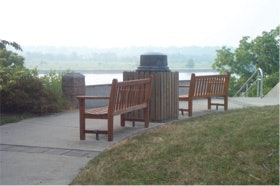"The number-one rule guiding the specification and placement of park and playground equipment? Do what feels right for the site."
 Park bench
Park bench
In fact, since its completion in 1878, Central Park's landscape has been altered numerous times, many of those alterations taking place in the mid-20th century under the purview of famed urban planner Robert Moses. While Moses is credited with cleaning up Central Park after a long period of neglect - sandblasting the park wall to its original dark cream color, reseeding lawns, repaving walks and repairing drinking fountains, among other improvements - he is also responsible for ignoring Frederick Law Olmsted's original pastoral vision for the park. In fact, Moses, who preferred recreation facilities to rural scenery, brought to Central Park 19 playgrounds, 12 ballfields, handball courts and an ice skating rink.
All in all, though, despite experiencing its fair share of tinkering over the years, Central Park's landscape has stopped short of being modified beyond recognition. Perhaps because they don't boast landmark status, unfortunately many other parks throughout the country haven't fared as well as Central Park. Whether a hack job takes place during initial construction or well after the fact, landscape architect Phil Enderle, a senior associate with Toledo, Ohio-based The Collaborative, believes that it's a shame it has to take place at all.
Admitting that it may sound a bit pedestrian, Enderle says that above all other rules of thumb in park and playground design, one should never do anything that doesn't feel right for the site.
According to Enderle, this rule applies to virtually all park design decisions - from the selection of trail pavement to the placement of park benches. "Believe it or not, your gut instinct will tell you where people will naturally want to pause," he says. "We'll walk the site, usually with the owners, and look for places where people will want to rest - whether that's under the canopy of a shade tree or adjacent to a ball field."
Despite operating under this pretext, creating and maintaining harmony among a park's various built and natural elements can still be tricky, especially as parks become increasingly versatile recreation destinations.
While it's true that a park's diversity of amenities can present landscape architects with some thematic challenges, those challenges can be significantly mitigated if designers keep in mind yet another caveat - every park has a personality.
And much like a house, that personality begins at the front door. "How do you make a park more identifiable?" asks Enderle. "You create portholes at entries to walking paths and trails. Decorative arches that may be at the entrances almost become welcome mats for the park. There, you may add drinking fountains and benches. You want to add scale and make it more human."
Then again, ours is an auto-centric society, and large, regional parks are becoming more commonplace, especially in suburban locales. It's inevitable that at such facilities, even outdoor recreation enthusiasts will occasionally be annoyed at having to hike from their cars to a park's amenities. "People don't want to walk a long distance from the parking lot, especially to facilities like playgrounds and pavilions," says Janna Tidwell, an associate with Schrickel, Rollins and Associates Inc., an Arlington, Texas-based landscape architecture, engineering and planning firm. "Often, they're carrying things for birthday parties, picnics and family events, and really want to shorten their route of travel."
But there's another reason why landscape architects would prefer to keep a tight perimeter. "You want to cluster things closer together so that you don't use up a lot of your valuable land," says Tidwell, noting that this task is obviously easier - and more imperative - to address with smaller parks. "At neighborhood parks, you really want to encourage people to walk to that park. That helps us reduce the amount of parking spaces that we have to provide. Those parking spaces take up land on which we could provide more recreational opportunities."
In larger parks, where it may not be as feasible to cluster various amenities near parking areas, landscape architects must work harder to retain a park's pleasurable first impression. (As Enderle reiterates: "When you're stepping out of your car, you need to step into that park.") To do so, designers can employ visual softening techniques such as berming - of course, using the site's existing topography to their advantage - to obscure parking areas from the view of park patrons and passersby.
Another simple strategy involves dressing up the paths upon which patrons walk from their cars to the park. "We've been using decorative pavers, especially in areas where you must have a lot of paving," says Tidwell. "Or by adding some colored concrete to the area, you can make the pavement a lot more appealing, soften it visually and reduce some of the glare."
Parking lots, as well as portholes and walking paths, are areas in which too much light isn't necessarily a bad thing. They should certainly feel secure, and that security can easily be provided through the proper placement of lighting fixtures. At portholes, for instance, Enderle recommends spacing fixtures to provide for anywhere from 3 to 5 foot-candles of light. "A lot of park districts don't want to spend money on lighting. Instead, they'll just say, `Our parks close at night,' " he says.
And then there are those park administrators who understand the value in extending their operational hours into the twilight - whether they do so for rec league ball games or dog-walkers - and realize that from their investment in lighting there are returns to be had, both in terms of revenue and park user loyalty. Says Tidwell, "You notice there's an increase in usage of those facilities because people are more comfortable and enjoy going to those places."
The comfort level of many park patrons will depend on a delicate balance achieved through proper bench placement. "People like to sit and be able to take in the activity around them," says Enderle. "But they don't like to sit where they feel as if they're on display."
For that reason, Enderle suggests meandering trails around and behind such active recreation spaces as ball diamonds and playgrounds, allowing active recreation participants to serve as the main event and those engaging in passive recreation to watch from the perimeter.
And while only a small percentage of patrons may care much about their ability to see and not be seen by their fellow park users, no one wants to notice the unattractive yet essential facilities that help keep a park functional. Indeed, it's not uncommon for storage sheds, rest rooms and utility buildings to function foremost as a park's eyesores. It's a concern not easily addressed, says Tidwell. "We're always met with the challenge of not only providing durable products, but things that are aesthetically pleasing, things that add something to the park. A lot of times, that's hard for a designer to do because you have to build these things to take not only the everyday wear and tear, but also some of the abuses they're occasionally subjected to."
While Tidwell says that powder-coated paint can often help soften the look of park buildings and shade structures, Curt Coronato, a landscape architect with Ward Associates P.C. of Bohemia, N.Y., will "use site topography and landscaping to try to hide outbuildings, but keep them accessible for the people who need to access them" - that is, if his firm is fortunate to be involved early enough in a park's master-planning phase.
Similarly, Enderle and his colleagues try to incorporate physical plant buildings into a park's design. One such solution involves locating a storage shed behind a four-sided shelter or pavilion. Three pillared sides are left open to adjacent activity spaces, while the fourth is a solid wall that obscures the shallow equipment shed attached to its opposite side. Moreover, the shed's doors open entirely out of view of pavilion users, while the pavilion can be situated so that the fourth wall blocks prevailing winds. "We don't think of it as a single element," says Enderle, referring to the requisite shed. "We look at it as part of the whole architecture of the park."
Additional park features that, if not handled creatively, might otherwise be relegated to eyesore status include retention basins, which can be turned into appealing water features such as ponds or marshes. Although Enderle says that doing so can be more expensive than ordering stock equipment from a catalog, subtly incorporating architectural details referencing local figures of historical or cultural impact can liven up water fountains, benches, light fixtures and trash receptacles. Fencing, too, can be easily dressed up. Enderle recommends outfitting portholes with decorative fencing, wrought iron and masonry being common choices. At Central Park, for example, an unsightly 7-foot-high chain-link fence surrounding the park's 106-acre Reservoir, erected in 1926, obscured joggers' and pedestrians' views of the Manhattan skyline. In 2003, the park's conservancy remedied the eyesore with a new 4-foot-high, 1.58-mile-long fence - made of steel with cast-iron ornamentation and set on the existing 8-inch granite coping stone - that closely resembles the original historic fence in place from 1864 to 1926.
Central Park's $2 million fence, funded by a generous donation from a deep-pocketed Manhattan couple, is a project likely far beyond the means of most park agencies. But wholescale removal isn't the only way to deal with the aesthetic challenges of chain-link fencing, which because of its affordability is often specified at parks for use throughout their grounds. "Put chain-link fencing along the perimeter of a ball field and nobody has a problem with it," says Enderle. "But put it anywhere else and people immediately think, `That area's off-limits because of security.' "
To reverse that psychology, park owners might consider undertaking one of several affordable upgrades: painting their chain-link fencing, adorning it with windscreens, decorative plastic guards or corrugated fence caps, or curving a fence to soften its industrial look and feel.
Much regarding a park's look and feel ultimately depends on the materials selected for its construction - and designers are benefited by a growing array of options in the specification of anything from rest-room fixtures to playground surfacing.
On playgrounds, asphalt and rocks are passe, as designers are increasingly laying down engineered wood-fiber mulch or poured-in-place rubber, surfaces that meet today's standards for both accessibility and safety. These surfaces also come in a variety of colors and playful patterns.
Cost is often a leading factor in specification decisions, but for some municipalities image continuity among their various parks and recreation facilities is just as important a consideration. "Sometimes, we'll try to match the type of benches with those in other area parks," says Coronato.
As simple as it may seem, a decision to pick like materials for all parks district-wide can also help simplify maintenance and replacement needs, especially considering the fact that park owners and designers now have more flexibility than ever in the selection of durable and attractive outdoor equipment such as benches, picnic tables and trash receptacles.
Such items are commonly made from recycled plastic, which can be ideal from both a durability standpoint - according to Coronato, it's not uncommon for such equipment to last 20 years - and an environmental one. In fact, many agencies can recoup much or all of the cost of purchasing environmentally friendly park equipment by applying for and receiving state and federal grants that encourage the use of eco-friendly materials in public spaces.
Energy-efficient plumbing and lighting fixtures can also help park owners cut costs. Tidwell recommends specifying lights that are activated by photocells or timers, as well as waterless urinals and photocell-activated flush valves, faucets, hand dryers, soap dispensers and paper-towel dispensers. Selecting such equipment is a telltale sign of environmental responsibility, says Enderle. "You're telling the public that the municipality is being a good steward of its natural resources."
The public is the primary constituency park administrators hope to appease. However, their responsible selection of park and playground equipment - coupled with a well-planned and sensitive strategy for its eventual placement - would also likely satisfy both Morris, who foresaw the future demand for active recreation facilities in parks, and Olmsted, the man who once admonished his chief apprentice to "never lose sight of the fact that our special responsibility as landscape artists applies primarily to the broad, comprehensive scenery."
Enderle does his best to keep both men's aims in mind. "When we do a master plan on a virgin site, we'll take a look at what areas are ideal for passive recreation and what areas are ideal for active recreation," he says. "A lot of times, the site itself will dictate to us where those things go."




































